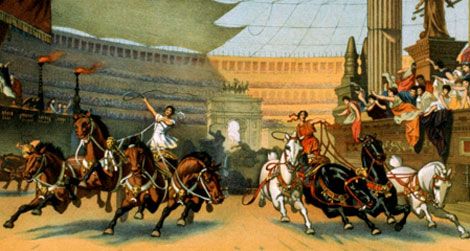
We may describe first the games in which the Roman himself participated and then those at which he was a mere spectator. He cared more for farces (mimes and pantomimes) than for the drama, tragic or comic but the one thing that really appealed to him was excitement, and this he found in gambling or in such amusements only as involved the risk of injury to life and limb-the sports of the circus and the amphitheater. The Roman made it hard and expensive, too, for others to amuse him. But there was no national game for the young men, and there were no social amusements in which men and women took part together. He played a few games of chance for the excitement the stakes afforded. In the country there might be hunting and fishing. He practiced riding, fencing, wrestling, hurling the discus, and swimming for the skill in arms and the strength they gave him. He played ball before dinner for the good of the exercise. Harold Whetstone Johnston wrote in “The Private Life of the Romans”: “After the games of childhood, the Roman did not, as we do, pass on to an elaborate system of competitive games. The arena had a seating capacity of 6,000, quite large when considering that London at the time only had 20,000 residents. A massive oak amphitheater excavated in London had chambers for wild animals and shrines used by gladiators who prayed before their battles and possible deaths. An even worse episode occurred at the Constantinople Hippodrome under the Byzantines when over 30,000 people were killed when a chariot race turned into riot against Emperor Justinian."*Īrenas and amphitheaters that hosted sporting events were found throughout the Roman empire. After one such incident in Pompeii, Emperor Nero forbade all such gatherings for ten years. The incidents usually began with spectators hurling insults at one another, then escalated into stone throwing melees and often ended in carnage when the combatants picked up weapons. Sporting events in ancient Rome often got out of hand. The Olympics, however, continued through the Roman era as a pagan festival, with Nero among those that attended, until they were shut down by the Christian Roman emperor Theodosius I, who ordered the closure of all pagan events in 393. Romans appear to have been more interested in gladiator battles, chariot races and large spectacles and less interested in drama and Olympic-style sports as was the case with ancient Greeks. Some racetracks were larger than NFL stadiums. Horses and athletes were given-performance-enhancing drugs. Events were often sponsored by wealthy citizens as displays of their wealth. The huge crowds that gathered in stadiums and forums to watch sporting events screamed " panem at Colosseum !" ("bread and circuses").

Chariot racing and gladiator battles were fixtures of religious festivals.

The Romans loved sports, some of which were quite brutal and bloody. The Romans transformed the athleticism and ritual of Greek sport into a spectacle.


 0 kommentar(er)
0 kommentar(er)
